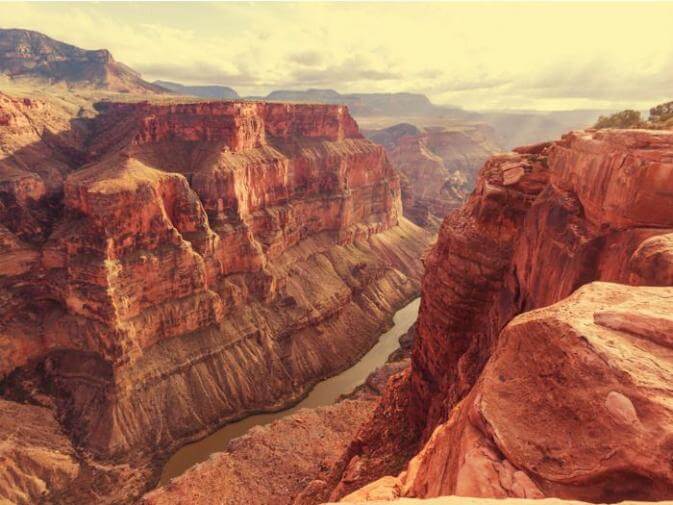
In the northwest corner of the state of Arizona, the Grand Canyon stretches 277 miles (446 km) long and 18 miles (29 km) at its widest. The canyon cuts as deep as a little over a mile (or 1800 m).
Named Ongtupqa in the Hopi language, the canyon is considered a passageway to the afterlife. The United States government gave the Grand Canyon national park status when President Woodrow Wilson signed the Grand Canyon National Park Act in 1919. The canyon is also home to 373 species of birds, 91 species of mammals, 58 species of reptiles and amphibians, and 18 species of fish, and sees over 5 million visitors each year.
Our fascination with the Grand Canyon has led to thousands of studies of its layered rock, its marine and terrestrial fossils, and its wildlife inhabitants. Geologists agree that the layers of colored rock that form the canyon’s walls are as old as 1.8 billion years. Scientists also agree that the great crevice in the Earth’s surface was cut away by the flow of the Colorado River. However one question is still debated: when exactly did this erosion happen?
When Did the Grand Canyon Form?
The region we now know as the Grand Canyon has changed dramatically over our planet’s history, at different times hosting multiple mountain ranges. Those mountains were eventually worn down by rain, wind, and frost until finally forming a plateau that was slowly but consistently carved little by little by the flow of the Colorado River.
There is substantial evidence that the Grand Canyon formed around 5 to 6 million years ago, and geologically speaking, that’s very recent. One spot that suggests to geologists that the Canyon is so young is known as Muddy Creek, home to a buildup of gravel, limestone, and lava. The lack of the type of sediment normally found in the Colorado River suggests the region was formed prior to the Colorado River passing through. If the river could not have exited the canyon through this spot any earlier than 5 to 6 million years ago, this sets an approximate upper limit to the age of the canyon.
But the findings from a few recent studies have begun to support the longstanding theory that the Grand Canyon was actually formed by the merging of two smaller “ancestral” canyons, one in the east and one in the west. In a 2012 study published in the journal Science, a team of geologists led by Professor Rebecca Flowers of the University of Colorado, Boulder, examined the concentrations of helium in different samples of rock from the east and west ends of the canyon.
Helium is produced by the decay of radioactive uranium found within a type of calcium phosphate mineral called an apatite that layers the walls of the Grand Canyon. When the apatite gets too close to the Earth’s surface, it’s temperature decreases, and helium can no longer escape from the rock through diffusion. Thus the amount of helium found in the rock layers offers clues as to that rock’s temperature history or when that rock reached the surface and thus when that portion of the canyon was formed. Flowers and her team used this method of thermochronology to determine the western portion of the Grand Canyon was already carved to within 70% of its current depth as long as 70 million years ago—a lot older than the original estimates of a few million years. The authors of the study found the eastern end of the canyon to be younger, around 15-25 million years old.
In the Grand Canyon, we are able to study millions of years of geologic evolution all in one place thanks to the 40 layers of rock that make up the canyon’s walls.
Using the same age dating techniques, a different group from the University of New Mexico in Albuquerque has come up with similar results, also placing the age of the eastern portion of the canyon at 15-25 million years. However, although their helium abundance results are similar, using different values for the temperature of the Earth’s surface and other differing initial conditions, they set the age for the western paleocanyon a bit younger, from 50 to 70 million years in a 2012 study published in Nature.
If the western side does date back to 70 million years ago, such an old age would mean the carving of the canyon predates the Colorado River as we know it today. Put another way, the original western paleocanyon was carved out by a cretaceous river to within a few hundred meters of its current depth, with the eastern paleocanyon having been carved to a lesser extent, before the Colorado River took over, merging the two canyons and creating a single drainage spot, at the relatively young, 6-million-year-old Muddy Creek.
In the Grand Canyon, we are able to study millions of years of geologic evolution all in one place thanks to the 40 layers of rock that make up the canyon’s walls. The Grand Canyon tells us about the environmental changes the Earth has faced and offers us a chance to marvel at the power of our planet to reshape itself.
Until next time, this is Sabrina Stierwalt with Everyday Einstein’s Quick and Dirty Tips for helping you make sense of science. You can become a fan of Everyday Einstein on Facebook or follow me on Twitter, where I’m @QDTeinstein. If you have a question that you’d like to see on a future episode, send me an email at everydayeinstein@quickanddirtytips.com.
Image courtesy of shutterstock.
Tidak ada komentar:
Posting Komentar